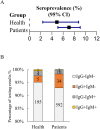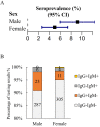Seroprevalence of Toxoplasma gondii infection among patients of a tertiary hospital in Guangzhou, Guangdong province, PR China
- PMID: 37428723
- PMCID: PMC10332624
- DOI: 10.1371/journal.pone.0286430
Seroprevalence of Toxoplasma gondii infection among patients of a tertiary hospital in Guangzhou, Guangdong province, PR China
Abstract
Purpose: This study aimed to explore the prevalence of Toxoplasma gondii (T. gondii) among patients in Guangzhou city, South China, and to identify susceptible patient populations and analyze the causes of infection differences.
Methods: From May 2020 to May 2022, a total of 637 sera were collected from patients, and 205 sera were collected from health participants as health control. All sera were examined by colloidal gold kits to detect the positivity of antibodies against T. gondii. And the positivity of antibodies in sera was confirmed with ARCHITECT i2000SR system.
Results: The prevalence of T. gondii infection in patients was 7.06% (45/637), which was lower than the prevalence in health participants 4.88% (10/205). Among patients, 34 (5.34%) were positive only for IgG, 10 (1.57%) were only for IgM, and 1 (0.16%) was positive for both IgG and IgM. There was a significant difference in prevalence between male and female patients, but not among different age groups or diseases groups. The prevalence of T. gondii infection in diseases groups varied. The prevalence was relatively high in patients with the disorders of thyroid gland and the malignant neoplasms of digestive organs, which suggests that caution should be taken to avoid T. gondii infection in these patients. Surprisingly, the prevalence was quite low in diffuse Large B-cell Lymphoma (DLBC) patients. This may be due to the overexpression of TNF-α in tumor tissues of DLBC patients and the higher protein level of TNF-α in sera of DLBC patients.
Conclusion: This study provides a systematic exploration of the prevalence of T. gondii infection in patients in a tertiary hospital. Our data contributes to a better understanding of the epidemic investigation of T. gondii among patients in South China, which can help the prevention and treatment of the disease caused by T. gondii infection.
Copyright: © 2023 Guan et al. This is an open access article distributed under the terms of the Creative Commons Attribution License, which permits unrestricted use, distribution, and reproduction in any medium, provided the original author and source are credited.
Conflict of interest statement
The authors have declared that no competing interests exist.
Figures







Similar articles
-
[Seroprevalence and risk factors of Toxoplasma gondii infections among high-risk populations in Changzhou City].Zhongguo Xue Xi Chong Bing Fang Zhi Za Zhi. 2020 Jul 29;32(6):635-639. doi: 10.16250/j.32.1374.2019282. Zhongguo Xue Xi Chong Bing Fang Zhi Za Zhi. 2020. PMID: 33325201 Chinese.
-
Seroprevalence and genetic characterization of Toxoplasma gondii in cancer patients in Anhui Province, Eastern China.Parasit Vectors. 2015 Mar 15;8:162. doi: 10.1186/s13071-015-0778-5. Parasit Vectors. 2015. PMID: 25889184 Free PMC article.
-
Seroprevalence of Toxoplasma gondii infection in people in southeast Hubei province, China.Trop Biomed. 2020 Jun 1;37(2):452-457. Trop Biomed. 2020. PMID: 33612814
-
Prevalence and predictors of Toxoplasma gondii infection in pregnant women from Dhamar, Yemen.BMC Infect Dis. 2019 Dec 30;19(1):1089. doi: 10.1186/s12879-019-4718-4. BMC Infect Dis. 2019. PMID: 31888517 Free PMC article.
-
Is Toxoplasma gondii a threat to the conservation of free-ranging Australian marsupial populations?Int J Parasitol Parasites Wildl. 2015 Dec 15;5(1):17-27. doi: 10.1016/j.ijppaw.2015.12.002. eCollection 2016 Apr. Int J Parasitol Parasites Wildl. 2015. PMID: 27141439 Free PMC article. Review.
References
-
- Alvarado-Esquivel C, Sanchez-Anguiano LF, Hernandez-Tinoco J, Ramos-Nevarez A, Estrada-Martinez S, Cerrillo-Soto SM, et al.. Association between Toxoplasma gondii infection and history of blood transfusion: a case-control seroprevalence study. The Journal of international medical research. 2018;46(4):1626–33. doi: 10.1177/0300060518757928 - DOI - PMC - PubMed
Publication types
MeSH terms
Substances
LinkOut - more resources
Full Text Sources
Medical
Research Materials

